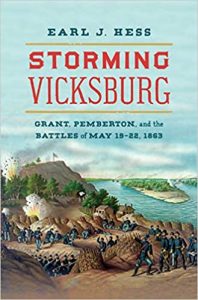Book Review: Storming Vicksburg
 Storming Vicksburg: Grant, Pemberton, and the Battles of May 19-22, 1863
Storming Vicksburg: Grant, Pemberton, and the Battles of May 19-22, 1863
By Earl J. Hess
University of North Carolina Press, 2020, $40.00 hardback
Reviewed by Sean Michael Chick
In 2020 Earl J. Hess and Timothy B. Smith, two of the top historians of the American Civil War, each released a book on Ulysses S. Grant ‘s failed attempts to storm Vicksburg from May 19-22, 1863. Hess’ work purports to be the more analytical of the two. Hess’ interest in Civil War tactics is the core of his analysis. I will not compare the two as I have not read Smith’s work, but given his previous scholarship, it is likely as good or better than Hess’ contribution.
There is much to admire in Hess’ Storming Vicksburg. The maps are quite good. The discussions of terrain, if not always clear, are detailed and support his argument that terrain was a major reason the Union lost 4,000 total men in the attacks. The pictures are also quite good. Instead of the usual images of Grant, Pemberton, Sherman, and Johnston, we get rare images of the lost Vicksburg cyclorama and key officers such as William Stone of the 22nd Iowa Infantry and Thomas J. Higgins of the 99th Illinois Infantry, who won the Medal of Honor. That said, the prose is better suited to the analysis of commanders and tactics than the narrative of battle. This is almost telegraphed by Hess himself, who in the text regards Smith ‘s book as more narrative than hardcore military history being provided in Storming Vicksburg.
Hess’ conclusions are not groundbreaking, but well argued. He purports that the Army of the Tennessee, while a great campaigning force, lacked coordination in making large scale assaults. He blames a lack of practice and states they did not attack at Shiloh, a strange idea considering the actions of April 7. The other contention, although he does not go quite so far, is that Grant and his corps commander, William Sherman, John McClernand, and James McPherson, failed as offensive tacticians. Of the group McClernand and McPherson come in for the most criticism. McPherson’s reputation as a general has faded over time, particularly after Albert Castel’s peerless Decision in the West. This book does nothing to reverse that trend.
McClernand has seen a small revival, and while Hess does praise McClernand’s drive and tactical instincts, he faults him for erroneous reports, poor coordination, and in his words being “a royal pain in everyone’s side.” Thus his removal is warranted. This reviewer disagrees, seeing McClernand’s removal as based solely on his attempt to get an independent western command after the fall of Corinth and his final split with Grant. Hess does not delve much into Grant’s motives for firing McClernand beyond the usual stuff about McClernand being a pain and mutual antipathy. A better analysis of the politics of command, where connections and party affiliation often trumped military ability, is ignored for arguing that removing McClernand was a military necessity, or at least justified. If that were the case McPherson deserved removal far more than Sherman or McClernand.
In analyzing Grant’s motives and actions, Hess is balanced. He criticizes Grant for merely shoving ahead without reserves and for misreading his army’s willingness to attack. The later point is briefly discussed as the soldier’s “right” to refuse to attack. This topic should be expanded in a book, for it is a battlefield dynamic rarely commented on, but can be gleamed from a close reading of sources, where reports mention “full assaults” but with light losses. Another of course is when an official reports reads “we fell back to resupply” you can bet the falling back was rarely of the orderly kind and a good excuse was needed.
Back to Grant though. Hess does not comment much on Grant’s unwillingness to ask for a truce, thereby leaving his men to suffer between the lines. Although we are given a vignette where Grant cries over looking at such men, the subject requires more than a few paragraphs. In my research on Vicksburg, limited as it is, I find both Union and Confederate soldiers mentioning this act in greater detail than Hess provides.
The Confederates are not as present in the text, being that they were on the defensive and many wished to forget Vicksburg in general, so the primary sources are fewer by comparison. Yet, Hess comments where he can and shows that for Pemberton, May 19-22 was possibly his career high point. While not a hard battle to win, he positioned his men well, made good use of reserves, and even made effective efforts to improve morale. As such, while Pemberton was clearly not a military giant, the text refuses the charges of military incompetence without falling into special pleading.
All in all this is a fine work. The prose may not sing, but it is clear and works well when not in service of a combat narrative. The maps and images are great and the analysis, even where I disagree, is well argued and researched. It is refreshing to read a book where the author has no clear favorites among the generals

Now that’s an interesting, concise review; really what I’m looking for. Thanks